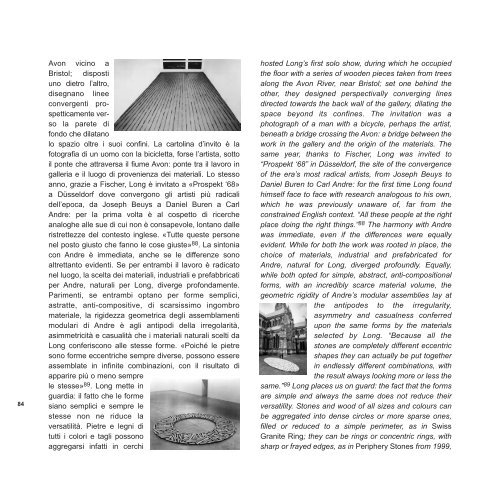Adachiara Zevi - arteinmemoria
Adachiara Zevi - arteinmemoria
Adachiara Zevi - arteinmemoria
Create successful ePaper yourself
Turn your PDF publications into a flip-book with our unique Google optimized e-Paper software.
84<br />
Avon vicino a<br />
Bristol; disposti<br />
uno dietro l’altro,<br />
disegnano linee<br />
convergenti prospetticamenteverso<br />
la parete di<br />
fondo che dilatano<br />
lo spazio oltre i suoi confini. La cartolina d’invito è la<br />
fotografia di un uomo con la bicicletta, forse l’artista, sotto<br />
il ponte che attraversa il fiume Avon: ponte tra il lavoro in<br />
galleria e il luogo di provenienza dei materiali. Lo stesso<br />
anno, grazie a Fischer, Long è invitato a «Prospekt ‘68»<br />
a Düsseldorf dove convergono gli artisti più radicali<br />
dell’epoca, da Joseph Beuys a Daniel Buren a Carl<br />
Andre: per la prima volta è al cospetto di ricerche<br />
analoghe alle sue di cui non è consapevole, lontano dalle<br />
ristrettezze del contesto inglese. «Tutte queste persone<br />
nel posto giusto che fanno le cose giuste» 88 . La sintonia<br />
con Andre è immediata, anche se le differenze sono<br />
altrettanto evidenti. Se per entrambi il lavoro è radicato<br />
nel luogo, la scelta dei materiali, industriali e prefabbricati<br />
per Andre, naturali per Long, diverge profondamente.<br />
Parimenti, se entrambi optano per forme semplici,<br />
astratte, anti-compositive, di scarsissimo ingombro<br />
materiale, la rigidezza geometrica degli assemblamenti<br />
modulari di Andre è agli antipodi della irregolarità,<br />
asimmetricità e casualità che i materiali naturali scelti da<br />
Long conferiscono alle stesse forme. «Poiché le pietre<br />
sono forme eccentriche sempre diverse, possono essere<br />
assemblate in infinite combinazioni, con il risultato di<br />
apparire più o meno sempre<br />
le stesse» 89 . Long mette in<br />
guardia: il fatto che le forme<br />
siano semplici e sempre le<br />
stesse non ne riduce la<br />
versatilità. Pietre e legni di<br />
tutti i colori e tagli possono<br />
aggregarsi infatti in cerchi<br />
hosted Long’s first solo show, during which he occupied<br />
the floor with a series of wooden pieces taken from trees<br />
along the Avon River, near Bristol; set one behind the<br />
other, they designed perspectivally converging lines<br />
directed towards the back wall of the gallery, dilating the<br />
space beyond its confines. The invitation was a<br />
photograph of a man with a bicycle, perhaps the artist,<br />
beneath a bridge crossing the Avon: a bridge between the<br />
work in the gallery and the origin of the materials. The<br />
same year, thanks to Fischer, Long was invited to<br />
“Prospekt ‘68” in Düsseldorf, the site of the convergence<br />
of the era’s most radical artists, from Joseph Beuys to<br />
Daniel Buren to Carl Andre: for the first time Long found<br />
himself face to face with research analogous to his own,<br />
which he was previously unaware of, far from the<br />
constrained English context. “All these people at the right<br />
place doing the right things.” 88 The harmony with Andre<br />
was immediate, even if the differences were equally<br />
evident. While for both the work was rooted in place, the<br />
choice of materials, industrial and prefabricated for<br />
Andre, natural for Long, diverged profoundly. Equally,<br />
while both opted for simple, abstract, anti-compositional<br />
forms, with an incredibly scarce material volume, the<br />
geometric rigidity of Andre’s modular assemblies lay at<br />
the antipodes to the irregularity,<br />
asymmetry and casualness conferred<br />
upon the same forms by the materials<br />
selected by Long. “Because all the<br />
stones are completely different eccentric<br />
shapes they can actually be put together<br />
in endlessly different combinations, with<br />
the result always looking more or less the<br />
same.” 89 Long places us on guard: the fact that the forms<br />
are simple and always the same does not reduce their<br />
versatility. Stones and wood of all sizes and colours can<br />
be aggregated into dense circles or more sparse ones,<br />
filled or reduced to a simple perimeter, as in Swiss<br />
Granite Ring; they can be rings or concentric rings, with<br />
sharp or frayed edges, as in Periphery Stones from 1999,


